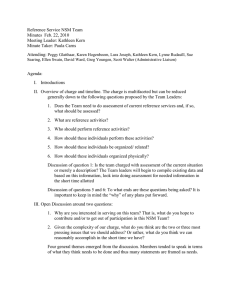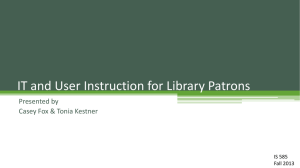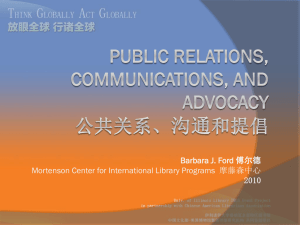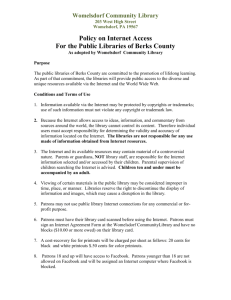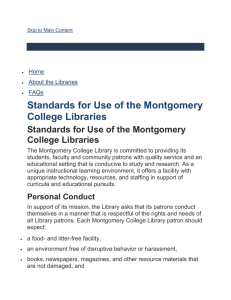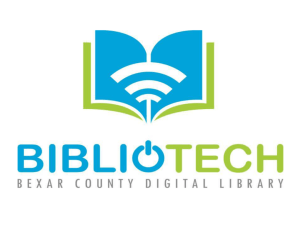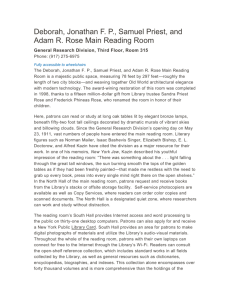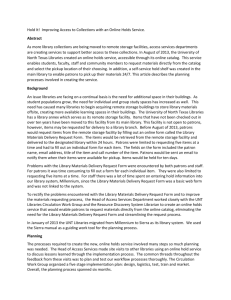Uribe Customer Service ARSL
advertisement
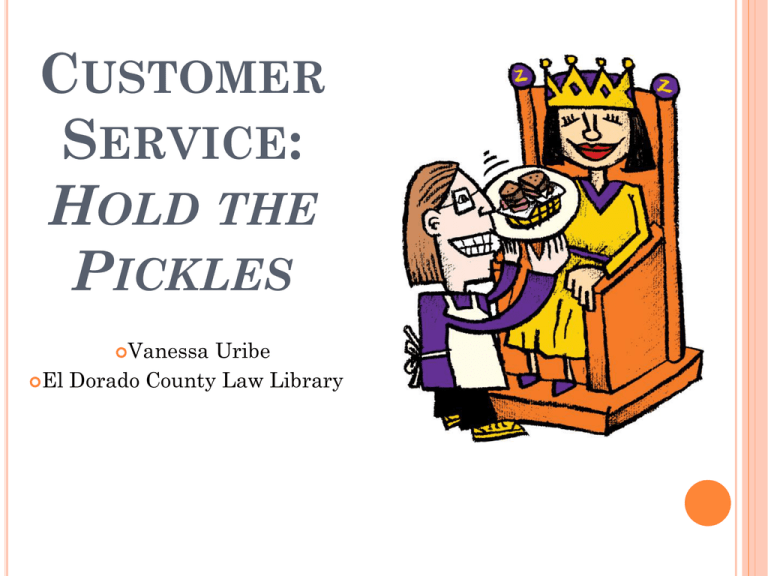
CUSTOMER SERVICE: HOLD THE PICKLES Vanessa Uribe El Dorado County Law Library ABOUT ME Rural Upbringing Have worked in school and public libraries Currently work in a rural public law library WHY NOW? WHY THIS AGAIN......... Workplace Stress (“new normal”= more with less) Great Experiences = Job Security Importance of teaching ZINGERMAN’S DELICATESSEN Ann Arbor, Michigan MORE ABOUT MY TRAINING....... LIBRARY CUSTOMER SERVICE TRAINING IMPORTANT ZINGERMANS DIFFERENCES • Customer Service is an Integral Part of the Mission/Vision/Values of the Organization • Customer Service is a Bottom Line Result BUILDING A CULTURE OF GREAT CUSTOMER SERVICE TEACH IT DEFINE IT LIVE IT MEASURE IT REWARD IT From Rework, by J. Fried and D. Hansson 1. TEACH IT! Discussion: Is customer service a skill you are born with; can it be taught? Why is it important to teach something? Engage people in open-ended questions Why is it important? Why is it so hard to find? 2. DEFINE IT Question: What does great customer service look like at your organization? DEFINING IT........CONTINUED Two Parts: • The Positive: The steps to providing great service • The Negative: The steps to handling customer complaints DEFINING GREAT CUSTOMER SERVICE: THREE STEPS 1. Figure out what the guest wants 2. Get it for them 3. Go the “Extra Mile” DEFINING IT........CONTINUED • Step 1: Figure out what the guest wants • Open-ended questions, restate request, be an active listener • 10/4 rule • Engage them DEFINING IT........CONTINUED • Step 2: Get it for them • Accurately • Politely • Enthusiastically DEFINING IT........CONTINUED • Step 3: Go the “Extra Mile” • What is an Extra mile? • Definition: Doing something for our customers that they did not ask us for EXAMPLES OF EXTRA MILES....... • • • • • • • Offer to search another library’s catalog for item not found in ours Offer to carry books out to car for customer with hands full Show customer some of the features of website Demonstrate a catalog search Compliment customer on book selection Offer a book recommendation Show customer a feature on website/database FIVE STEPS TO EFFECTIVELY HANDLING CUSTOMER COMPLAINTS 1. Acknowledge the complaint 2. Sincerely Apologize 3. Take action to make things right 4. Thank the guest 5. Document the complaint A NOTE ON FAIRNESS: Fairness is on another planet 3. “LIVE IT” “We need to distinguish between the values and visions to which we give lip service and those that are truly the basis for our actions” - Sam Keen, Hymns to an Unknown God Barriers to Customer Service Study Public Librarian # Lack of effective marketing 1 Personality characteristics of patrons 2 Unapproachability of staff 8 Staff too reliant on computer resources "if it's not online it doesn't exist" 1 Lack of face to face interactions due to technology 1 Librarianship is trivilaized/not regarded as important ("women's work") 1 Lack of funding 2 Library facilities and signage 8 Lack of measurement for CS outcomes 1 Lack of appropriate training (communication & continuing education) 11 Libraries too driven by policy and procedure 13 Patrons and staff "not speaking the same language" 4 Collection Development/collection 1 Sexual harassment of library staff 1 Staff stratification, no cross training 1 Lack of Outreach 1 Staff aversion to change 2 Burnout/"compassion fatigue" 3 Lack of seeing patrons as "individuals" 3 Reference interactions, "negative closure" 3 Staffing: turnover or part timers 3 Bad morale 1 Staff: lack of education 2 Total Responses 74 4. “MEASURE IT” Systems role in customer service In order to gauge how well systems are operating, you have to measure their effectiveness Example forms: “Code Red” “Code Green” 5. “REWARD IT!” Professional Advancement Sell the Service Group Rewards PROMISING PRACTICES…… Libraries Peer Recognition Programs Vouchers for library video rentals or items from book sale Library manager does the job of staff member for an hour Other Industries Monetary rewards (“ZingBuck”) Regular company communications Customer service practices tied into promotions OVERCOMING CHALLENGES IN RURAL LIBRARIES Customer service training can be a tool to help overcome challenges in rural libraries Manage stressful interactions with patrons Identify systemic problems with library Identify positive attributes of library Ongoing focus and dialog about customer service eliminates the need for tedious trainings Makes a better workplace and attracts likeminded potential employees
